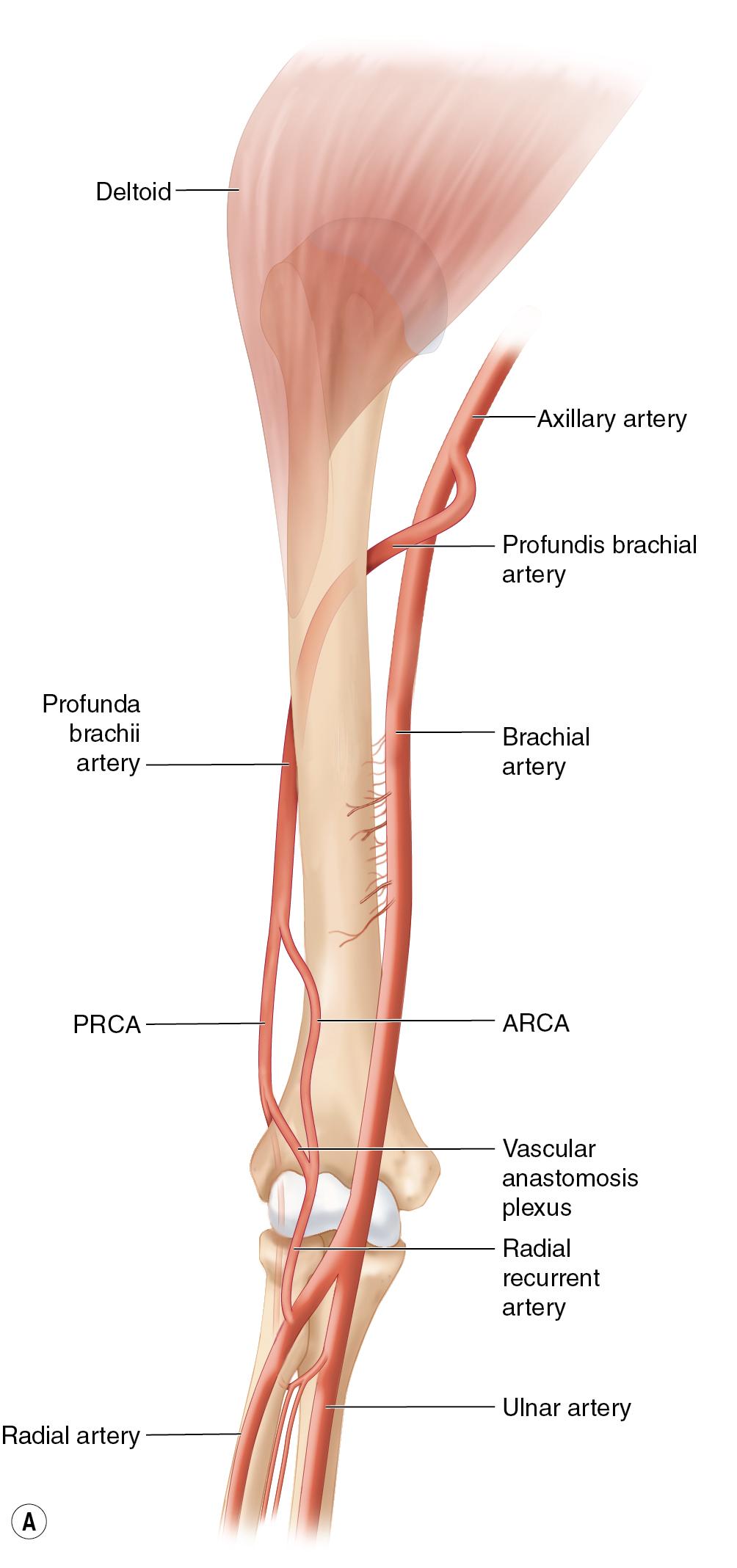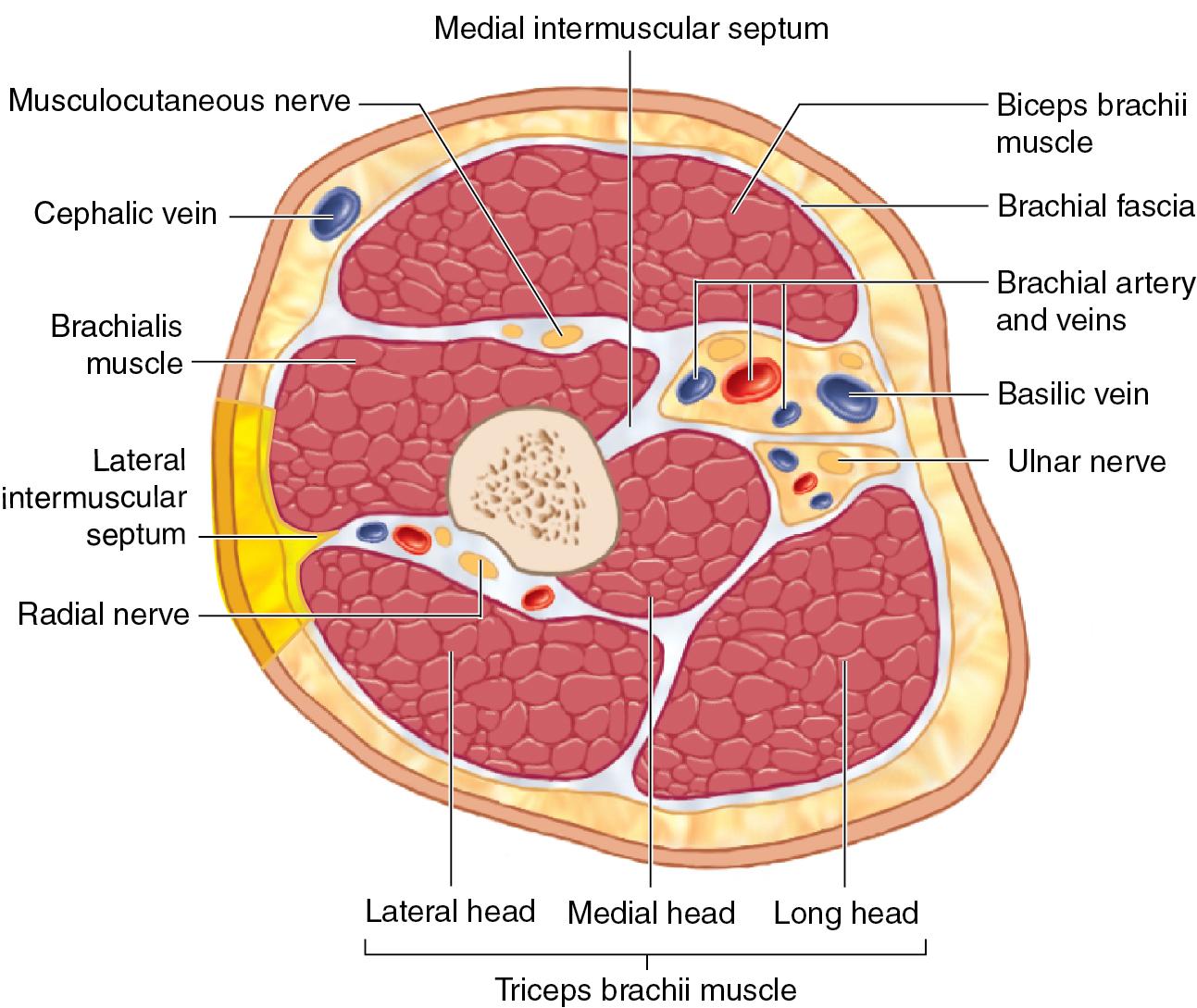Physical Address
304 North Cardinal St.
Dorchester Center, MA 02124
In both free antegrade and pedicled reverse designs, the lateral arm flap is useful for coverage and resurfacing of forearm, elbow, and dorsal hand wounds. It is thin, has fascia to provide a tendon gliding surface, and has a consistent vascular pedicle that does not require intramuscular perforator dissection. The donor site can often be closed primarily.
The free antegrade lateral arm flap is based on the posterior radial collateral artery and is useful for first webspace contracture release. Its proximal pedicle can be anastomosed to the radial artery in the distal wrist and remains covered with flap skin, avoiding the need for the pedicle to travel in a potentially compressive tunnel.
The pedicled reverse lateral arm flap is based on the radial recurrent artery and can be used to cover exposed hardware of the olecranon or resurface the antecubital fossa after contracture release.
The free lateral arm flap can reconstruct a composite defect with loss of bone, tendon, or nerve using a vascularized segment of the humerus bone, triceps tendon, or posterior cutaneous nerve, respectively.
Although the donor site defect can be closed directly, the scar is visible on the lateral arm. Aesthetic considerations should be taken into account.
The lateral arm flap should be avoided in patients who find a long scar on the lateral arm cosmetically unacceptable.
Other thin flap options can also be considered based on availability and appearance, such as a groin flap, super thin anterolateral thigh flap, or medial sural artery perforator flap.
A free flap should not be performed if there are any previous injuries to the intended recipient vessels.
Examine the lateral arm and epicondyle for sequelae of prior trauma or surgery that could compromise flap reliability.
Estimate whether enough laxity exists to close the donor site primarily after flap harvest.
Use a handheld Doppler to mark the perforators that the skin paddle is centered on.
The flap axis is along the line between the deltoid insertion and the lateral epicondyle. The cutaneous perforators are given off within the distal half of the line, and the most distal perforator is 3 to 5 cm proximal to the lateral epicondyle ( Fig. 92.1 ).

The pedicled reverse lateral arm flap is often used for coverage of the elbow, exposed olecranon hardware, or the antecubital fossa after contracture release. The pivot point is at the lateral epicondyle and brachioradialis (BR), which is where the radial recurrent artery anastomoses with the posterior radial collateral artery through a rich vascular plexus.
A preoperative angiogram is not necessary. It can be useful, however, to confirm the presence of an intact pedicle if adjacent tissue is traumatized.
The free antegrade flap is based on the posterior radial collateral artery and its septocutaneous perforators (see Fig. 92.1 ).
The posterior radial collateral artery travels in the lateral intermuscular septum, between the triceps and brachialis proximally ( Fig. 92.2 ) and the triceps and BR and triceps and extensor carpi radialis longus (ECRL) distally. Thus, starting with the posterior dissection as described later, the triceps is raised off the septum, and the intermuscular septum is then raised off the brachialis, BR, and ECRL.

The posterior radial collateral artery anastomoses with the radial recurrent artery. This forms the basis for the pedicled reverse lateral arm flap, which relies on retrograde flow from the radial recurrent artery.
The radial recurrent artery comes off the radial artery in the antecubital fossa, ulnar to the biceps tendon. This is also known as the Leash of Henry and is a compression point for the radial nerve in the radial tunnel. Because the radial recurrent artery anastomoses with the posterior radial collateral artery, it comes off the radial artery ulnar to BR, travels superficially through BR to the lateral elbow, and then merges with the posterior radial collateral artery. It courses over the lateral epicondyle not as a macroscopic axial vessel, but as a rich anastomostic network above the deep fascia. The pivot point for the reverse flap is centered over the BR and lateral epicondyle to capture these vessels.
The brachial artery gives off the profunda brachii artery just after the axillary artery becomes the brachial artery distal to teres major. The profunda brachii travel through the triangular interval with the axillary nerve, coursing along the spiral groove of the humerus between the deltoid insertion and origin of the medial head of the triceps.
At the lateral intermuscular septum, the profunda brachii bifurcates into the anterior and posterior radial collateral arteries. The anterior radial collateral artery is of inconsistent caliber and continues with the radial nerve as it enters the anterior compartment of the arm between the brachialis and BR.
The posterior radial collateral artery is larger and more consistent. It remains in the lateral intermuscular septum and travels distal toward the lateral epicondyle, terminating in a rich vascular network about the lateral elbow.
The venous flow of the free lateral arm flap is provided by one or two venae comitantes of the posterior radial collateral artery. The diameter of the venae comitantes is approximately 2 mm.
The posterior antebrachial cutaneous nerve travels with the flap.
The patient is positioned supine with the limb placed on a hand table. The flap is harvested with the arm in pronation and the elbow in flexion.
The entire donor arm, extending to the shoulder, should be prepped up to the axilla.
A sterile tourniquet is placed as proximally as possible.
The flap can be harvested from the ipsilateral or contralateral limb.
Become a Clinical Tree membership for Full access and enjoy Unlimited articles
If you are a member. Log in here